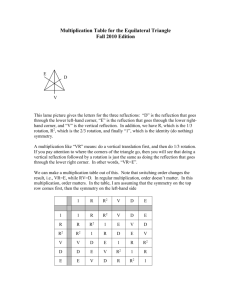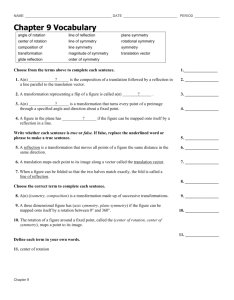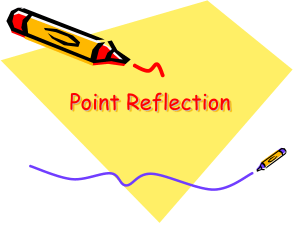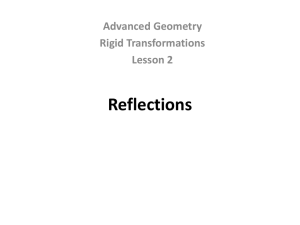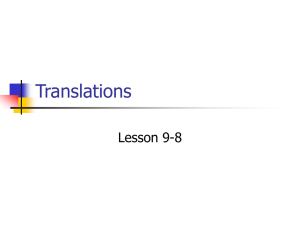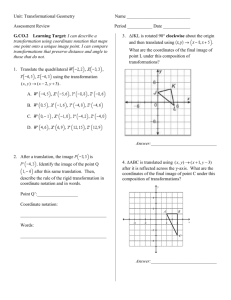Chapter 10: Geometric Symmetry and the Golden Ratio
advertisement
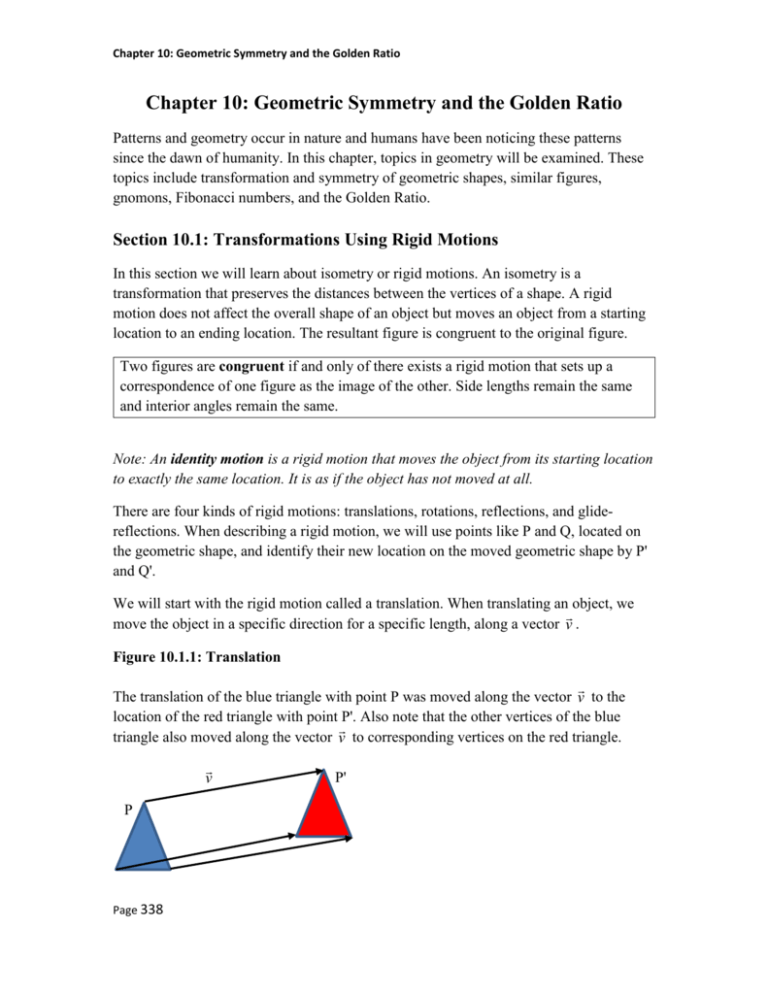
Chapter 10: Geometric Symmetry and the Golden Ratio Chapter 10: Geometric Symmetry and the Golden Ratio Patterns and geometry occur in nature and humans have been noticing these patterns since the dawn of humanity. In this chapter, topics in geometry will be examined. These topics include transformation and symmetry of geometric shapes, similar figures, gnomons, Fibonacci numbers, and the Golden Ratio. Section 10.1: Transformations Using Rigid Motions In this section we will learn about isometry or rigid motions. An isometry is a transformation that preserves the distances between the vertices of a shape. A rigid motion does not affect the overall shape of an object but moves an object from a starting location to an ending location. The resultant figure is congruent to the original figure. Two figures are congruent if and only of there exists a rigid motion that sets up a correspondence of one figure as the image of the other. Side lengths remain the same and interior angles remain the same. Note: An identity motion is a rigid motion that moves the object from its starting location to exactly the same location. It is as if the object has not moved at all. There are four kinds of rigid motions: translations, rotations, reflections, and glidereflections. When describing a rigid motion, we will use points like P and Q, located on the geometric shape, and identify their new location on the moved geometric shape by P' and Q'. We will start with the rigid motion called a translation. When translating an object, we move the object in a specific direction for a specific length, along a vector v . Figure 10.1.1: Translation The translation of the blue triangle with point P was moved along the vector v to the location of the red triangle with point P'. Also note that the other vertices of the blue triangle also moved along the vector v to corresponding vertices on the red triangle. v P Page 338 P' Chapter 10: Geometric Symmetry and the Golden Ratio A translation of an object moves the object along a directed line segment called a vector v for a specific distance and in a specific direction. The motion is completely determined by two points P and P' where P is on the original object and P' is on the translated object. In regular language, a translation of an object is a slide from one position to another. You are given a geometric figure and an arrow which represents the vector. The vector gives you the direction and distance which you slide the figure. Example 10.1.1 Translation of a Triangle You are given a blue triangle and a vector v . Move the triangle along vector v . Figure 10.1.2: Blue Triangle and Vector v B A C v Figure 10.1.3: Result of the Translation B’ A’ C’ A C B v Page 339 Chapter 10: Geometric Symmetry and the Golden Ratio Properties of a Translation 1. A translation is completely determined by two points P and P’ 2. Has no fixed points 3. Has identity motion v Note: the vector v has the same length as vector v , but points in the opposite direction. Example 10.1.2 Translation of an Object Given the L-shape figure below, translate the figure along the vector v . The vector v moves horizontally three units to the right and vertically two units up. Move each vertex three units to the right and two units up. The red figure is the position of the L-shape figure after the slide. Figure 10.1.4: L-Shape and Vector v P v Figure 10.1.5: Result of the L-Shape Translated by Vector v P' P v Page 340 Chapter 10: Geometric Symmetry and the Golden Ratio The next type of transformation (rigid motion) that we will discuss is called a rotation. A rotation moves an object about a fixed point R called the rotocenter and through a specific angle. The blue triangle below has been rotated 90° about point R. A rotation of an object moves the object around a point called the rotocenter R a certain angle either clockwise or counterclockwise. Note: the rotocenter R can be outside the object, inside the object or on the object. Figure 10.1.6: A Triangle Rotated 90° around the Rotocenter R outside the Triangle 90° R Figure 10.1.7: A Triangle Rotated 180° around the Rotocenter R inside the Triangle R Properties of a Rotation 1. A Rotation is completely determined by two pairs of points; P and P’ and Q and Q’ 2. Has one fixed point, the rotocenter R 3. Has identity motion the 360° rotation Page 341 Chapter 10: Geometric Symmetry and the Golden Ratio Example 10.1.3: Rotation of an L-Shape Given the diagram below, rotate the L-shaped figure 90° clockwise about the rotocenter R. The point Q rotates 90°. Move each vertex 90° clockwise. Figure 10.1.8: L-Shape and Rotocenter R The L-shaped figure will be rotated 90° clockwise and vertex Q will move to vertex Q'. Each vertex of the object will be rotated 90°. Q 90° Q' R Figure 10.1.9: Result of the 90° Clockwise Rotation Q Q' R Page 342 Chapter 10: Geometric Symmetry and the Golden Ratio Example 10.1.4: 45° Clockwise Rotation of a Rectangle Figure 10.1.10: Rectangle and Rotocenter R Q 45° Q' R Figure 10.1.11: Result of 45° Clockwise Rotation Q Q' R Example 10.1.5: 180° Clockwise Rotation of an L-Shape Figure 10.1.12: L-Shape and Rotocenter R A B R 180° Page 343 Chapter 10: Geometric Symmetry and the Golden Ratio Figure 10.1.13: Result of the 180° Clockwise Rotation A B R B' A' The next type of transformation (rigid motion) is called a reflection. A reflection is a mirror image of an object, or can be thought of as “flipping” an object over. Reflection: If each point on a line l corresponds to itself, and each other point P in the plane corresponds to a unique point P in the plane, such that l is the perpendicular bisector of PP , then the correspondence is called the reflection in line l . In regular language, a reflection is a mirror image across a line l . The line l is the midpoint of the line between the two points, P in the original figure and P’ in the reflection. P goes to P’. Figure 10.1.14: Reflection of an Object about a Line l C B A l Page 344 Chapter 10: Geometric Symmetry and the Golden Ratio Figure 10.1.15: Result of the Reflection over Line l The reflection places each vertex along a line perpendicular to l and equidistant from l. C' C B' B A' A l Properties of a Reflection 1. A reflection is completely determined by a single pair of points; P and P’ 2. Has infinitely many fixed points: the line of reflection l 3. Has identity motion the reverse reflection Example 10.1.6 Reflect an L-Shape across a Line l Figure 10.1.16: L-shape and Line l B C A l Reflect the L-shape across line l. The red L-shape shown below is the result after the reflection. The original position of each vertex is on a line with the reflected position of each vertex. This line that connects the original and reflected positions of the vertex is perpendicular to line l and the original and reflected positions of each vertex are equidistant to line l. Page 345 Chapter 10: Geometric Symmetry and the Golden Ratio Figure 10.1.17: Result of Reflection over Line l B' C' A' l Example 10.1.7: Reflect another L-Shape across Line l First identify the vertices of the figure. From each vertex, draw a line segment perpendicular to line l and make sure its midpoint lies on line l. Now draw the new positions of the vertices, making the transformed figure a mirror image of the original figure. Figure 10.1.18: L-Shape and Line l B A l C D Page 346 Chapter 10: Geometric Symmetry and the Golden Ratio Figure 10.1.19: Result of Reflection over Line l B A C D C' B' A' D' The final transformation (rigid motion) that we will study is a glide-reflection, which is simply a combination of two of the other rigid motions. A glide-reflection is a combination of a reflection and a translation. Example 10.1.8 Glide-Reflection of a Smiley Face by Vector v and Line l Figure 10.1.20: Smiley Face, Vector v , and Line l v l Page 347 Chapter 10: Geometric Symmetry and the Golden Ratio Figure 10.1.21: Smiley Face Glide-Reflection Step One First slide the smiley face two units to the right along the vector v . v v l Figure 10.1.22: Smiley Face Glide-Reflection Step Two Then reflect the smiley face across line l. The final result is the green upsidedown smiley face. v l Properties of a Glide-Reflection 1. A reflection is completely determined by a single pair of points; P and P. 2. Has infinitely fixed points: the line of reflection l. 3. Has identity motion the reverse glide-reflection. Page 348 Chapter 10: Geometric Symmetry and the Golden Ratio Example 10.1.9: Glide-Reflection of a Blue Triangle Figure 10.1.23: Blue Triangle, Vector v , and Line l l v Figure 10.1.24: Triangle Glide-Reflection Step One First, slide the triangle along vector v . v l P* P Page 349 Chapter 10: Geometric Symmetry and the Golden Ratio Figure 10.1.25: Triangle Glide-Reflection Step Two Then, reflect the triangle across line l. The final result is the green triangle below line l. v Q* P* S* P’ S’ Q’ Example 10.1.10: Glide-Reflection of an L-Shape Figure 10.1.26: L-Shape, Vector v , and Line l v l Page 350 Chapter 10: Geometric Symmetry and the Golden Ratio Figure 10.1.27: L-Shape Glide-Reflection Step One First slide the L-shape along vector v . v B* B A* A Figure 10.1.28: L-Shape Glide-Reflection Step Two Then reflect the L-shape across line l. The result is the green open shape below the line l. v B* A’ B B’ Page 351 Chapter 10: Geometric Symmetry and the Golden Ratio Section 10.2: Connecting Transformations and Symmetry Humans have long associated symmetry with beauty and art. In this section, we define symmetry and connect it to rigid motions. A symmetry of an object is a rigid motion that moves an object back onto itself. There are two categories of symmetry in two dimensions, reflection symmetries and rotation symmetries. A reflection symmetry occurs when an object has a line of symmetry going through the center of the object, and you can fold the object on this line and the two halves will “match.” An object may have no reflection symmetry or may have one or more reflection symmetries. A rotation symmetry occurs when an object has a rotocenter in the center of the object, and the object can be rotated about the rotocenter some degree less than or equal to 360° and is a “match” to the original object. Every object has one or more rotation symmetries. D-Type Symmetry: Objects that have both reflection symmetries and rotation symmetries are Type Dn where n is either the number of reflection symmetries or the number of rotation symmetries. If an object has both reflection and rotation symmetries, then it is always the same number, n , of each kind of symmetry. Z-Type Symmetry: Objects that have no reflection symmetries and only rotation symmetries are Type Z n where n is the number of the rotation symmetries. Example 10.2.1: Symmetries of a Pentagon Identify the reflection and the rotation symmetries of the pentagon. The five dashed lines shown on the figure below are lines of reflection. The pentagon can be folded along these lines back onto itself and the two halves will “match” which means that the pentagon has a reflection symmetry along each line. Page 352 Chapter 10: Geometric Symmetry and the Golden Ratio Figure 10.2.1: Reflection Symmetries of a Pentagon Also, there are five vertices of the pentagon and there are five rotation symmetries. The angle of rotation for each rotation symmetry can be calculated 360 72 . So, if you 5 rotate the upper vertex of the pentagon to any other vertex, the resulting object will be a match to the original object, and thus a symmetry. by dividing 360° by the number of vertices of the object: Figure 10.2.2: Rotation Symmetries of a Pentagon 72° 144° 288° 360° 216° When an object has the same number of reflection symmetries as rotation symmetries, we say it has symmetry type Dn Therefore, the pentagon has symmetry type D5 because it has five reflection symmetries and five rotation symmetries. Page 353 Chapter 10: Geometric Symmetry and the Golden Ratio Example 10.2.2: Symmetries of a Smiley Face Identify the rotation and the reflection symmetries of the smiley face. There is one line of reflection that will produce a reflection symmetry as shown below, and the only rotation symmetry is 360°, also shown below. Figure 10.2.3: The Smiley Face has Symmetry Type D1 360° Example 10.2.3: Symmetry Type D1 Figure 10.2.4: Some Letters with Symmetry Type D1 The following letters are all examples of symmetry type D1 since they each have only one axis of reflection that will produce a symmetry as shown below, and they each have only one rotation symmetry, 360. B C A E T Example 10.2.4: Symmetries of a Pinwheel Identify the rotation and reflection symmetries of a pinwheel. Figure 10.2.5: There are No Reflection Symmetries of the Pinwheel Page 354 Chapter 10: Geometric Symmetry and the Golden Ratio Figure 10.2.6: There are Five Rotation Symmetries of the Pinwheel 360 72 . The 5 rotation symmetries of the pinwheel are 72°, 144°, 216°, 288°, and 360°. We find the angle by dividing 360° by five pinwheel points; 72 144 288 360 216 When an object has no reflection symmetries and only rotation symmetries, we say it has symmetry type Z n . The pinwheel has symmetry type Z 5 . Example 10.2.5: Symmetries of the Letter S Identify the rotation and the reflection symmetries of the letter S. Figure 10.2.7: The Letter S There are no reflection symmetries and two rotation symmetries; 180° and 360°, therefore the letter S has symmetry type Z 2 . S S 180° and 360 Page 355 Chapter 10: Geometric Symmetry and the Golden Ratio Example 10.2.6: Symmetries of the Card the Eight of Hearts Identify the rotation and reflection symmetries of card the eight of hearts. The card shown below has no reflection symmetries since any reflection would change the orientation of the card. At first, it may appear that the card has symmetry type Z 2 . However, when rotated 180°, the top five hearts will turn upside-down and it will not be the same. Therefore, this card has only the 360 rotation symmetry, and so it has symmetry type Z1 . Figure 10.2.8: The Eight of Hearts and its 180 Rotation Example 10.2.7: Other Examples of Symmetry Type Z n Figure 10.2.9: A Design and the Letter K a. b. K a. The design has symmetry type Z 6 , no reflection symmetries and six rotation symmetries. To find the degrees for the rotation symmetries, divide 360 by the 360 60 . Thus, the six rotation symmetries are number of points of the design: 6 60, 120, 180, 240, 300, and 360. Page 356 Chapter 10: Geometric Symmetry and the Golden Ratio b. The letter K has symmetry type Z1 , no reflection symmetries and one rotation symmetry (360). Section 10.3: Transformations that Change Size and Similar Figures This section covers transformations that either enlarge or shrink an object from a point, P. The point P is called the center of the size transformation. The multiplier used to enlarge or shrink the object is called the scale factor, k. The calculations used to make the transformation depend on the distances from point P to the vertices of the object. These distances are multiplied by k. So, to enlarge or shrink an object, find the distance from the point P to a vertex A of the object. Multiply this distance by k to get kPA, where PA represents the distance from P to A. Then, measure this new distance, kPA, from point P in the direction of vertex A. This distance gives the new location of vertex A after the object has been size-transformed. Repeat for all vertices of the object. Example 10.3.1: Enlarge a Triangle by a Factor of Two Figure 10.3.1: Triangle to be Size-Transformed by a Factor of Two B P A Step 1: Measure the distances from point P to each vertex of the triangle. One vertex of the triangle is on point P, so that vertex will remain at point P. The distance from point P to vertex A is three units. The distance from point P to vertex B is also three units. Step 2: Multiply these distance by the scale factor two. 2PA = 2(3) = 6 2PB = 2(3) = 6 Page 357 Chapter 10: Geometric Symmetry and the Golden Ratio Step 3: Measure six units from point P in the direction of vertex A and measure six units from point P in the direction of vertex B. The new locations of A and B are each six units from P in their corresponding directions as shown below. Figure 10.3.2: Triangle Enlarged by a Factor of Two B’ B P A A’ Example 10.3.2: Enlarge a Diamond by a Factor of Two Figure 10.3.3: Diamond to be Size-Transformed by a Factor of Two B A D C P Step 1: Measure the distances from point P to each vertex of the diamond. The distance from point P to vertex A is PA Likewise, the distances from point P to the other three vertices are PB, PC, and PD, respectively. Step 2: Multiply these distance by the scale factor two. The distances of the new points from P are: 2PA, 2PB, 2PC, and 2PD. Page 358 Chapter 10: Geometric Symmetry and the Golden Ratio Step 3: Measure these distances from point P in the direction of each vertex A, B, C, and D as shown below. Figure 10.3.4: Diamond Enlarged by a Factor of Two B' A' D' B A D C' C P Example 10.3.3: Shrink a Trapezoid by a Factor of 1 2 Figure 10.3.5: Trapezoid to be Size-Transformed by a Factor of B 1 2 C P A D Step 1: Measure the distances from point P to each vertex of the trapezoid. The distances from point P to the vertices are PA, PB, PC, and PD, respectively. Step 2: Multiply these distances by the scale factor The distances of the new points from P are: 1 . 2 1 1 1 1 PA, PB, PC, and PD. 2 2 2 2 Page 359 Chapter 10: Geometric Symmetry and the Golden Ratio Step 3: Measure these distances from point P in the direction of each vertex A, B, C, and D as shown below. Figure 10.3.6: Trapezoid Shrunk by a Factor of B 1 2 C B' C' P A' D' A D Shapes that have been transformed by a enlarging or shrinking are similar figures to the original shape. Similarity Using Transformations Two figures are similar if and only if there exists a combination of an isometry (rigid motion) and a size transformation that generates one figure as the image of the other. Similar figures are figures that have the same shape but not necessarily the same size. Side lengths and interior angles of similar figures are proportional to each other. Figure 10.3.7: Similar Figures The two rectangles below are similar if the sides are proportional to each other. In other a c words, they are similar if . b d a c b d The two rectangles are related by the scale factor k. Therefore, the sides of the rectangles are related to each other by: c ka and d kb . Page 360 Chapter 10: Geometric Symmetry and the Golden Ratio Let P = perimeter of the smaller rectangle and P = perimeter of the larger rectangle. P c c d d P 2c 2d , but remember that c ka and d kb , so P 2ka 2kb , now factor out the k to get P k 2a 2b , and also, P 2a 2b , so P kP If P represents the perimeter of the smaller rectangle and P represents the perimeter of the larger rectangle, then the two perimeters are related by P kP . Let A = area of the smaller rectangle and A = the area of the larger rectangle. A c d , but remember that c ka and d kb , so A ka kb , rearrange to get A k 2 a b , and also, A a b , so A k 2 A If A represents the area of the smaller rectangle and A represents the area of the larger rectangle, then the two areas are related by A k 2 A . Example 10.3.4: Areas and Perimeters of Similar Triangles Figure 10.3.8: The Triangles in this Figure are Similar Triangles 4 16 a. Determine the perimeter P of the larger triangle if the perimeter P of the smaller triangle is 12 mm. Page 361 Chapter 10: Geometric Symmetry and the Golden Ratio b. Determine the area A of the larger triangle if the area A of the smaller triangle is 6.9 𝑚𝑚2 First, find the scale factor using the fact that similar triangles have sides that are 16 proportional to each other: k 4. 4 a. P kP P 4 12 48 P 48 mm b. A k 2 A A 42 6.9 16 6.9 110.4 A 110.4 mm2 Gnomons A gnomon is a shape which, when added to a shape A , yields another shape A that is similar to the original shape A . Alternately, a gnomon is also the shape which, when subtracted from a shape A , yields another shape A which is similar to the original shape A . Figure 10.3.9: What is a Gnomon? The blue rectangle shown below is the original shape A . When the red L-shape is attached to the blue rectangle, a new rectangle is formed, called shape A . If the red Lshape is a gnomon to shape A , then the blue rectangle (shape A ) is similar to the blue and red rectangle (shape A ). Also, since the rectangles are similar, the side lengths are a ax proportional: b b y b a b+y Shape A Gnomon Page 362 a+x Shape A Chapter 10: Geometric Symmetry and the Golden Ratio Example 10.3.5: Rectangular Gnomon Find the value of x so that the red larger rectangle on the right is a gnomon to the blue smaller rectangle on the left. Figure 10.3.10: Rectangular Gnomon 3 x Gnomon 9 To calculate this, set up a proportion so that the sides of the small blue rectangle on the left are proportional to the sides of the blue and red rectangles (left and right) combined. To set up the proportion, make ratios of the width over the length of the small blue rectangle on the left and the width over the length of the combined rectangles. width length 3 9 9 3 x 3(3 x) 81 9 3 x 81 3 x 72 x 24 If x 24 , then the red larger rectangle is a gnomon to the blue smaller rectangle. Example 10.3.6: Triangular Gnomon Find the values of x and y so that the larger red triangle on the left is a gnomon to the smaller blue triangle on the right. Figure 10.3.11: Triangular Gnomon x Gnomon y 15 12 9 Page 363 Chapter 10: Geometric Symmetry and the Golden Ratio To calculate this, set up proportions, one with x and one with y, so that the sides of the smaller blue triangle on the right are proportional to the sides of the blue and red triangles combined. To set up the proportion for x, make ratios of the longer leg over the shorter leg of the smaller blue triangle on the right and the longer leg over the shorter leg of the combined triangles. 9 15 12 x 9 x 180 x 20 Now to set up the proportion for y, make ratios of the shorter leg over the hypotenuse of the smaller blue triangle on the right and the shorter leg over the hypotenuse of the combined triangles. 9 15 15 y 9 9(y 9) 225 9 y 81 225 9 y 144 y 16 If x 20 and y 16 , then the red larger triangle on the left is a gnomon to the blue smaller triangle on the right. Section 10.4: Fibonacci Numbers and the Golden Ratio A famous and important sequence is the Fibonacci sequence, named after the Italian mathematician known as Leonardo Pisano, whose nickname was Fibonacci, and who lived from 1170 to 1230. This sequence is: 1, 1, 2, 3, 5, 8, 13, 21, 32, 55,.. This sequence is defined recursively. This means each term is defined by the previous terms. Page 364 Chapter 10: Geometric Symmetry and the Golden Ratio Given f1 1, f 2 1, then f3 f 2 f1 1 1 2, f 4 f 3 f 2 2 1 3, f5 f 4 f3 3 2 5 and so on. The Fibonacci sequence is defined by f n f n1 f n2 , for all n 3 , when f1 1 and f 2 1. In other words, to get the next term in the sequence, add the two previous terms. 1, 1, 2, 3, 5, 8, 13, 21, 34, 55, 55 34 89, 89 55 144, The notation that we will use to represent the Fibonacci sequence is as follows: f1 1 , f 2 1 , f3 2 , f 4 3 , f5 5 , f 6 8 , f7 13 , f8 21 , f9 34 , f10 55 , f11 89 , f12 144 , Example 10.4.1: Finding Fibonacci Numbers Recursively Find the 13th, 14th, and 15th Fibonacci numbers using the above recursive definition for the Fibonacci sequence. First, notice that there are already 12 Fibonacci numbers listed above, so to find the next three Fibonacci numbers, we simply add the two previous terms to get the next term as the definition states. f13 f12 f11 144 89 233 f14 f13 f12 233 144 377 f15 f14 f13 377 233 610 Therefore, the 13th, 14th, and 15th Fibonacci numbers are 233, 377, and 610 respectively. Page 365 Chapter 10: Geometric Symmetry and the Golden Ratio Calculating terms of the Fibonacci sequence can be tedious when using the recursive formula, especially when finding terms with a large n. Luckily, a mathematician named Leonhard Euler discovered a formula for calculating any Fibonacci number. This formula was lost for about 100 years and was rediscovered by another mathematician named Jacques Binet. The original formula, known as Binet’s formula, is below. Binet’s Formula: The nth Fibonacci number is given by the following formula: 1 5 n 1 5 n 2 2 fn 5 Binet’s formula is an example of an explicitly defined sequence. This means that terms of the sequence are not dependent on previous terms. A somewhat more user-friendly, simplified version of Binet’s formula is sometimes used instead of the one above. Binet’s Simplified Formula: The nth Fibonacci number is given by the following formula: 1 5 n 2 fn 5 Note: The symbol means “round to the nearest integer.” Example 10.4.2: Finding f10 Explicitly Find the value of f10 using Binet’s simplified formula. 1 5 10 10 2 1.618033989 55.003636 55 f10 5 5 Page 366 Chapter 10: Geometric Symmetry and the Golden Ratio Figure 10.4.1: Calculator Work for f10 Example 10.4.3: Finding f19 Explicitly Find the value of f19 using Binet’s simplified formula. 1 5 19 19 2 1.618033989 f19 4180.999952 4181 5 5 Figure 10.4.2: Calculator Work for f19 Page 367 Chapter 10: Geometric Symmetry and the Golden Ratio Example 10.4.4: Finding f 40 Explicitly Find the value of f 40 using Binet’s simplified formula. 1 5 40 40 2 1.618033989 f 40 102,334,155 5 5 Figure 10.4.3: Calculator Work for f 40 All around us we can find the Fibonacci numbers in nature. The number of branches on some trees or the number of petals of some daisies are often Fibonacci numbers Figure 10.4.4: Fibonacci Numbers and Daisies a. Daisy with 13 petals b. Daisy with 21 petals a. b. (Daisies, n.d.) Page 368 Chapter 10: Geometric Symmetry and the Golden Ratio Fibonacci numbers also appear in spiral growth patterns such as the number of spirals on a cactus or in sunflowers seed beds. Figure 10.4.5: Fibonacci Numbers and Spiral Growth a. Cactus with 13 clockwise spirals b. Sunflower with 34 clockwise spirals and 55 counterclockwise spirals a. b. (Cactus, n.d.) (Sunflower, n.d.) Another interesting fact arises when looking at the ratios of consecutive Fibonacci numbers. 2 3 5 8 13 21 1 2, 1.5 , 1.66 , 1.6 , 1.625 , 1.615385 , 1, 1 2 3 5 8 13 1 34 55 89 144 233 1.619048 , 1.617647 , 1.618182 , 1.617978 , 1.618056 , 21 34 55 89 144 377 610 987 1.618026 , 1.618037 , 1.618033 , 233 377 610 It appears that these ratios are approaching a number. The number that these ratios are getting closer to is a special number called the Golden Ratio which is denoted by (the Greek letter phi). You have seen this number in Binet’s formula. 1 5 2 The Golden Ratio has the decimal approximation of 1.6180339887 . The Golden Ratio: The Golden Ratio is a special number for a variety of reasons. It is also called the divine proportion and it appears in art and architecture. It is claimed by some to be the most Page 369 Chapter 10: Geometric Symmetry and the Golden Ratio pleasing ratio to the eye. To find this ratio, the Greeks cut a length into two parts, and let the smaller piece equal one unit. The most pleasing cut is when the ratio of the whole length x 1 to the long piece x is the same as the ratio of the long piece x to the short piece 1. 1 x x 1 x x 1 cross-multiply to get x 1 x 2 rearrange to get x 2 x 1 0 solve this quadratic equation using the quadratic formula. a 1, b 1, and c 1 x (1) (1) 2 4(1)(1) 1 5 2(1) 2 x 1 5 1 5 and x 2 2 The Golden Ratio is a solution to the quadratic equation x 2 x 1 meaning it has the property 2 1 . This means that if you want to square the Golden Ratio, just add one to it. To check this, just plug in . 2 1 2 1 5 1 5 1 2 2 1.618 2 1.618 1 2.618 2.618 It worked! Another interesting relationship between the Golden Ratio and the Fibonacci sequence occurs when taking powers of . Page 370 Chapter 10: Geometric Symmetry and the Golden Ratio 3 2 ( 1) 2 ( 1) 2 1 3 2 1 4 3 (2 1) 2 2 2( 1) 3 2 4 3 2 5 4 (3 2) 3 2 2 3( 1) 2 5 3 5 5 3 6 5 (5 3) 5 2 3 5( 1) 3 8 5 6 8 5 And so on. Notice that the coefficients of and the numbers added to the term are Fibonacci numbers. This can be generalized to a formula known as the Golden Power Rule. Golden Power Rule: n f n f n 1 where f n is the nth Fibonacci number and is the Golden Ratio. Example 10.4.5: Powers of the Golden Ratio Find the following using the golden power rule: a. 8 and b. 15 a. n f n f n 1 8 f8 f81 8 f8 f 7 8 211.618 13 46.978 b. n f n f n 1 15 f15 f151 15 f15 f14 15 610 1.618 377 1363.98 Page 371 Chapter 10: Geometric Symmetry and the Golden Ratio Chapter 10 Homework 1. Identify the image of point P under the following transformations. a. a translation along vector v b. a reflection across line l c. a counterclockwise rotation of 90° about point O d. A glide-reflection across l and along u v E O u B C D l A P 2. Identify the image of point P under the following transformations. a. a translation along vector u b. a reflection across line l c. a counterclockwise rotation of 90° about point O d. A glide-reflection across l and along v v D l C O E u B P A Page 372 Chapter 10: Geometric Symmetry and the Golden Ratio 3. Identify the image of point P under the following transformations. a. a translation along vector v b. a reflection across line l c. a counterclockwise rotation of 90° about point O d. A glide-reflection across l and along u F v C E O P A l B u 4. Identify the image of point P under the following transformations. a. a translation along vector v b. a reflection across line l c. a clockwise rotation of 90° about point O d. A glide-reflection across l and along u C F l E v O P A B u Page 373 Chapter 10: Geometric Symmetry and the Golden Ratio 5. Identify the image of point P under the following transformations. a. a translation along vector v b. a reflection across line l c. a clockwise rotation of 90° about point O d. A glide-reflection across l and along u F E v P l O A B u C 6. Translate the figure along vector v . v Page 374 Chapter 10: Geometric Symmetry and the Golden Ratio 7. Translate the figure along vector v . v 8. Translate the figure along vector v . v 9. Translate the figure along vector v . v Page 375 Chapter 10: Geometric Symmetry and the Golden Ratio 10. Rotate the figure 90° clockwise about the rotocenter R. R 11. Rotate the figure 90° clockwise about the rotocenter R. R 12. Rotate the figure 180° clockwise about the rotocenter R. R Page 376 Chapter 10: Geometric Symmetry and the Golden Ratio 13. Rotate the figure 180° clockwise about the rotocenter R. R 14. Reflect the figure over the line l. l 15. Reflect the figure over the line l. l Page 377 Chapter 10: Geometric Symmetry and the Golden Ratio 16. Reflect the figure over the line l. l 17. Reflect the figure over the line l. l 18. Glide-reflect the figure over the line l and along the vector v . l v Page 378 Chapter 10: Geometric Symmetry and the Golden Ratio 19. Glide-reflect the figure over the line l and along the vector v . l v 20. Glide-reflect the figure over the line l and along the vector v . l v 21. Glide-reflect the figure over the line l and along the vector v . l v Page 379 Chapter 10: Geometric Symmetry and the Golden Ratio 22. In the figures below, identify the types of symmetry. If there are rotation symmetries, identify the degree(s) of rotation. If there are reflection symmetries, draw the line(s) of reflection. a. b. 23. In the figures below, identify the types of symmetry. If there are rotation symmetries, identify the degree(s) of rotation. If there are reflection symmetries, draw the line(s) of reflection. a. b. 24. In the figures below, identify the types of symmetry. If there are rotation symmetries, identify the degree(s) of rotation. If there are reflection symmetries, draw the line(s) of reflection. a. Page 380 b. Chapter 10: Geometric Symmetry and the Golden Ratio 25. In the figures below, identify the types of symmetry. If there are rotation symmetries, identify the degree(s) of rotation. If there are reflection symmetries, draw the line(s) of reflection. a. b. 26. In the figures below, identify the types of symmetry. If there are rotation symmetries, identify the degree(s) of rotation. If there are reflection symmetries, draw the line(s) of reflection. a. b. 27. In the figures below, identify the types of symmetry. If there are rotation symmetries, identify the degree(s) of rotation. If there are reflection symmetries, draw the line(s) of reflection. a. b. Page 381 Chapter 10: Geometric Symmetry and the Golden Ratio 28. Enlarge the figure with respect to the point P by a factor of 2. P 29. Enlarge the figure with respect to the point P by a factor of 2. P Page 382 Chapter 10: Geometric Symmetry and the Golden Ratio 30. Enlarge the figure with respect to the point P by a factor of 2. P 31. Enlarge the figure with respect to the point P by a factor of 2. P Page 383 Chapter 10: Geometric Symmetry and the Golden Ratio 32. Shrink the figure with respect to the point P by a factor of 1 . 2 P 33. Shrink the figure with respect to the point P by a factor of P Page 384 1 . 2 Chapter 10: Geometric Symmetry and the Golden Ratio 34. Shrink the figure with respect to the point P by a factor of 1 . 2 P 35. Shrink the figure with respect to the point P by a factor of 1 . 2 P Page 385 Chapter 10: Geometric Symmetry and the Golden Ratio 36. Triangles A and A are similar and are related by the scale factor of 3. a. If the perimeter of triangle A is 12 ft, find the perimeter of A . b. If the area of triangle A is 8 𝑓𝑡 2 , find the area of A . 37. Triangles A and A are similar and are related by the scale factor of 4. a. If the perimeter of triangle A is 48 ft, find the perimeter of A . b. If the area of triangle A is 140 𝑓𝑡 2 , find the area of A . 38. Triangles A and A are similar and are related by the scale factor of 5. a. If the perimeter of triangle A is 42 ft, find the perimeter of A . b. If the area of triangle A is 68 𝑓𝑡 2 , find the area of A . 39. Triangles A and A are similar and are related by the scale factor of 2. a. If the perimeter of triangle A is 42 ft, find the perimeter of A . b. If the area of triangle A is 80 𝑓𝑡 2 , find the area of A . 40. The shapes A and A are similar. A A 8 18 a. If the perimeter of rectangle A is 22 ft, find the perimeter of A . b. If the area of rectangle A is 24 𝑓𝑡 2 , find the area of A . Page 386 Chapter 10: Geometric Symmetry and the Golden Ratio 41. The shapes A and A are similar. A A 12 18 a. If the perimeter of triangle A is 32 ft, find the perimeter of A . b. If the area of triangle A is 48 𝑓𝑡 2 , find the area of A . 42. Find the value of x so that the red larger rectangle on the right is a gnomon to the blue smaller rectangle on the left. 10 4 x 43. Find the value of x so that the red L-shape is a gnomon to the blue rectangle. 8 12 x 15 Page 387 Chapter 10: Geometric Symmetry and the Golden Ratio 44. Find the value of x so that the red triangle on the right is a gnomon to the blue triangle on the left. 9 9 6 6 x 45. Find the values of x and y so that the red trapezoid is a gnomon to the blue triangle. 4 5 3 1.5 y x 46. Compute the values of the following. a. F12 b. F4 F3 F2 c. F432 47. Compute the values of the following. Page 388 a. F13 b. F5 F3 F1 c. F531 Chapter 10: Geometric Symmetry and the Golden Ratio 48. Compute the values of the following using Binet’s simplified formula. a. F54 b. F65 c. F876 49. Compute the values of the following using Binet’s simplified formula. a. F35 b. F45 c. F987 50. Solve the quadratic equation x 2 x 3 0 . 51. Solve the quadratic equation x 2 3 x 3 0 . 52. Solve the quadratic equation x 2 5 x 3 0 . 53. Solve the quadratic equation x 2 4 x 7 0 . 54. Solve the quadratic equation x 2 x 7 0 . 55. Solve the quadratic equation x 2 x 5 0 . Page 389
